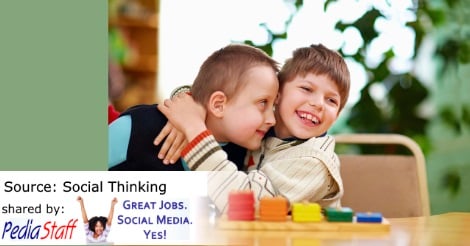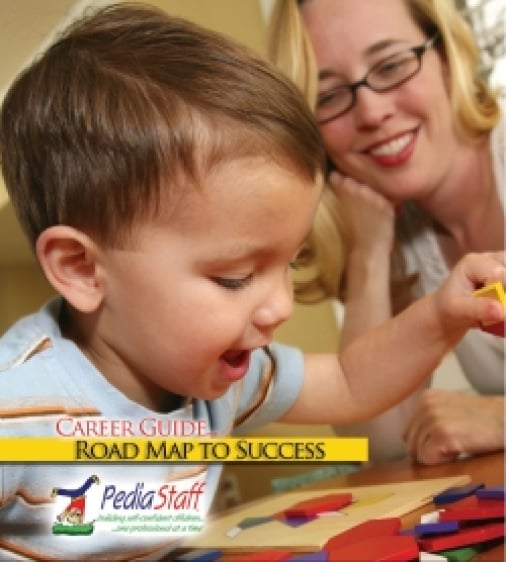Speech-Language Pathology Corner: Four Steps of Communication

Source: Social Thinking
By: Michelle Garcia Winner, MA, CCC-SLP
The four steps of communication help to define how the communicative act is heavily anchored in a synergistic process that involves the mind, the body, the eyes and language. More specifically, it involves social emotional thought, the nuance of physical presence and visually processing non-verbal cues in addition to language use and interpretation. As obvious as these steps may sound to the reader, the reality is that most speech and language social treatment programs teach students to focus almost exclusively on their social language production, called ‘conversational skills’ when teaching students how to be more appropriately social, often working with them seated around therapy tables while practicing having conversations. The four steps of communication strongly encourage us to recognize the social communicative act as being synergistic, always involving the first three steps, but not necessarily involving the fourth.
Step 1: Thinking about others and what they are thinking about us
We think about who we are near or who we want to talk to. If we are going to talk to someone, we consider what information we may already know about this person or what information we can infer based on the situation. For example, if you want to talk to the new student in your class, you have to think about what you may know about that student even if you have never met them before. For example, I know they are new to the class, I know they are a student, I know they live in my community; I know they have been in previous school environments, etc.
Step 2: Establishing a physical presence
When we desire to communicate or ‘hang out’ with another, or just need to communicate with another person, we have to establish a physical presence to show the person that we desire their company or intend to speak to them. The reverse is also true, if we want to avoid another person, we actively avoid establishing a physical presence. If we seek social interaction, our physical presence can include standing close enough to the person (often about an arm’s length away in the American culture), having our shoulders turned towards the other person(s) and keeping our body relaxed to move easily to include other people, or to move away from a person as needed.
Our physical presence is a non-verbal way to signal possible communicative intentionality. For example, if you are thinking about me, and you want to hang out with me but you are standing about four feet away and looking elsewhere, even if you are wishing I would talk to you, you are failing to convince me you desire to communicate with me. If you stand four feet away from me and attempt to converse with me, I am now confused since you have not first established physical presence, and now I just have a weird thought about you unless the context dictates you stand this distance from me (e.g., a physical barrier keeps you from moving closer).
One of the most consistent problems of persons with ASD and related disabilities in the school environment is that they fail to be able to spontaneously find groups of students to work with during group time in the classroom because they do not quickly and efficiently establish their physical presence with desired student workmates when the teacher tells them to go find a group to work with. Physical presence also includes the non-verbal physical attributes of communication including voice intensity, prosody and your ability to appear relaxed in another’s presence. However, the decision to target these even more abstract physical communication skills in treatment is highly dependent upon the student’s self- awareness and ability to self-monitor their own skill set. These later named physical communication skills require more sophisticated self-monitoring lacking in many of our school-aged students. It is this author’s hypothesis that our language provides content around which we relate, but it is our physicality that helps to relax and emotionally engage communicative partners.
Step 3: “Thinking with our eyes”
As we are thinking about the person we seek to communicate with and we establish physical presence, our intention to communicate is only explicitly clear once we have established eye contact with the other person. Furthermore, our eyes help to interpret emotional responses and track shifts in thinking of our communicative partner (e.g., joint attention) while also demonstrating social expectation that we are listening to our communicative partner.
While Step 2 signals possible social intent, Step 3 solidifies communicative intent. Further, as the eyes and body work in close synchronicity, observations of persons establishing communicative interactions clarify that a person will physically approach others without establishing direct eye-contact and that a new person entering a group slowly establishes eye contact only after they have established their initial physical presence in the group. There are exceptions to this scenario that also can be addressed. For example, when a person needs to communicate an urgent message, the eyes precede a person’s physical presence.
Step 4: Using language to relate to others
While language is central to all socially-based communication, it is often ineffective if the first three steps are not in place. For example, if a student comes up to tell you all the details about the Titanic and talks endlessly without considering what you are thinking and approaches with awkward physical presence and without establishing eye contact, the listener cannot help but experience a weird thought about the communicator even if his information may be interesting to listen to, In fact, the lack of the speaker’s adjustment based on the perceived needs of the listener makes this a failed attempt at conversing. When communicating, language users must consider and possibly adjust their message based on the thoughts, feelings, prior knowledge, experiences, intentions, and needs of their communicative partner. Each partner has to work to regulate his or her language to meet the needs of the listener while also conveying the message that helps to add his or her own thoughts to the interaction. Effective social communication requires students to ask questions about other people, produce supportive responses, and add their own thoughts by connecting their experiences or thoughts to what other people are saying. Thus, students must have a strong language system to be able to carry out this complex dialogue.
It is also important for the parent/educator/counselor to understand students can be perceived as ‘hanging out’ with their peers if they engage well in the first three steps of communication. For highly verbal students such as those with Asperger syndrome, a strong treatment need is to teach that communication is not all about talking. The caregiver may have to spend some time with the students focusing on the first three steps while limiting student talk during their treatment time to help them become better observers of communication.
Article Reprinted with Permission of Michelle Garcia Winner and Social Thinking
Michelle Garcia Winner, over the past decade, has developed these resources for professionals, parents and the broader public. In 2008, Michelle received a Congressional award for her development of social thinking as the basis for curricula in a variety of educational and therapeutic settings around the country. The Journal of Autism and Developmental Disorders has also published research supporting the social thinking methodologies she’s developed. In addition to writing nine books on the subject, Michelle travels around the world speaking on the issues relating to this approach that has assisted individuals with autism spectrum disorders (particularly higher-functioning autism, Asperger’s, NLD and similar) and she receives praise for her educational, energetic and innovative workshop presentations. She serves on the Panel of Professional Advisors of the Autism Society of America.
Please support our contributing authors and visit Social Thinking
PediaStaff is Hiring!
All JobsPediaStaff hires pediatric and school-based professionals nationwide for contract assignments of 2 to 12 months. We also help clinics, hospitals, schools, and home health agencies to find and hire these professionals directly. We work with Speech-Language Pathologists, Occupational and Physical Therapists, School Psychologists, and others in pediatric therapy and education.
